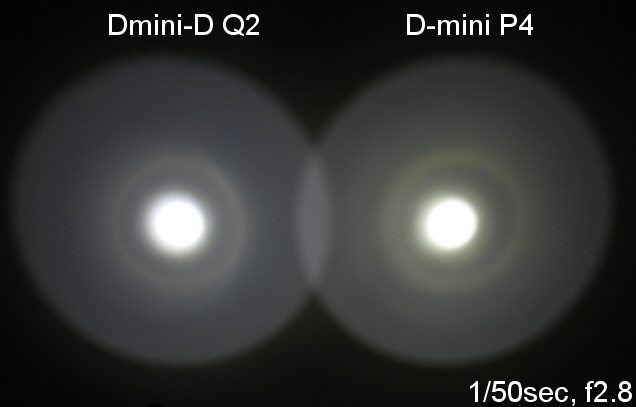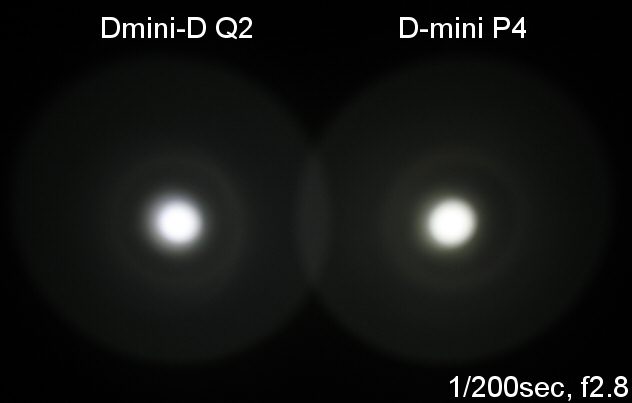EDIT 11/8/07: Turns out you can still lock-out the light with a 1/4 turn at the tailcap, even though the threads are not anodized. Not sure how they've managed this, but my apologies for not realizing it earlier. 
This thread is a comparison of the new digital 3-stage Q2 D-mini compared to the previous single/resistored 2-stage P4 version
The contenders:
From left to right: original P4 D-mini (black type II anodized), new digital Q2 D-mini (natural HA-III)

As you will notice, the new digital multi-stage D-mini is a little taller, thanks to the protruding GITD tailcap and forward clicky used to switch modes.
Beamshots:
On Hi with AW protected RCR
Note: These beamshots are misleading, as there is no difference in initial output on RCR (although the new digital version gets slightly brighter over time on RCR). But there is a large increase in output on primaries with the new digital Q2 version (see runtimes and summary below).


Note: all pics and throw measurements done with the original smooth reflector.
As you can see, beam profiles are very similar. Tint bin on the new digital Q2 D-mini is a premium white bin (I'd estimate WC), while my original P4 was a warmer tint (likely WG).
Method: All my output numbers are relative for my home-made light box setup, a la Quickbeam's FR.com method. My relative overall output numbers are typically similar to his, although generally a little lower. You can directly compare all my review graphs - i.e. an output value of "10" in one graph is the same as "10" in another.
Throw values are the square-root of lux measurements taken at 1m using a light meter.
Summary Chart

Runtimes:
Hi mode on Energizer primaries

Med/Lo modes on Energizer primaries

Hi mode on AW protected RCR

Med/Lo mode on AW protected RCR

General observations:
Digital control: I'm not sure how the new digital D-mini regulates its low modes, but if it uses PWM the frequency is too high for me to detect by eye or by instrument.
Memory: The new digital D-mini lacks a dedicated memory mode that retains last setting used. Instead, the light comes on in the following initial sequence: Hi - Med - Lo, repeat (cycle accessed by soft-pressing the forward clicky until the desired mode is found). According to Ricky at LP, if you leave the light on in any mode for more than 2 secs, after turning it off it will come back on at the start of the initial sequence (i.e. Hi), and cycle from there. In my case, it seems more like ~5 secs, and I see a momentary flash at that point letting me know the memory resest has been activated. If you turn the light off before the 5 sec period, it will move along to the next mode in the sequence when you turn it back on.
Interface: You soft-press the forward clicky repeatedly to switch between modes, and click for lock-on. You can also click on/off to change modes if you are fast enough. If you leave the light on for more 5 secs in any mode, the light will revert back to the initial sequence at the next start up (i.e. Hi). Forward clicky switch works well and is easy to access with good tactile feel.

Build Quality

Accessories

Output
Conclusion:
There you have it - a worthwhile upgrade to classic light. Cheers! :wave:

This thread is a comparison of the new digital 3-stage Q2 D-mini compared to the previous single/resistored 2-stage P4 version
The contenders:
From left to right: original P4 D-mini (black type II anodized), new digital Q2 D-mini (natural HA-III)

As you will notice, the new digital multi-stage D-mini is a little taller, thanks to the protruding GITD tailcap and forward clicky used to switch modes.
Beamshots:
On Hi with AW protected RCR
Note: These beamshots are misleading, as there is no difference in initial output on RCR (although the new digital version gets slightly brighter over time on RCR). But there is a large increase in output on primaries with the new digital Q2 version (see runtimes and summary below).


Note: all pics and throw measurements done with the original smooth reflector.
As you can see, beam profiles are very similar. Tint bin on the new digital Q2 D-mini is a premium white bin (I'd estimate WC), while my original P4 was a warmer tint (likely WG).
Method: All my output numbers are relative for my home-made light box setup, a la Quickbeam's FR.com method. My relative overall output numbers are typically similar to his, although generally a little lower. You can directly compare all my review graphs - i.e. an output value of "10" in one graph is the same as "10" in another.
Throw values are the square-root of lux measurements taken at 1m using a light meter.
Summary Chart

Runtimes:
Hi mode on Energizer primaries

Med/Lo modes on Energizer primaries

Hi mode on AW protected RCR

Med/Lo mode on AW protected RCR

General observations:
Digital control: I'm not sure how the new digital D-mini regulates its low modes, but if it uses PWM the frequency is too high for me to detect by eye or by instrument.
Memory: The new digital D-mini lacks a dedicated memory mode that retains last setting used. Instead, the light comes on in the following initial sequence: Hi - Med - Lo, repeat (cycle accessed by soft-pressing the forward clicky until the desired mode is found). According to Ricky at LP, if you leave the light on in any mode for more than 2 secs, after turning it off it will come back on at the start of the initial sequence (i.e. Hi), and cycle from there. In my case, it seems more like ~5 secs, and I see a momentary flash at that point letting me know the memory resest has been activated. If you turn the light off before the 5 sec period, it will move along to the next mode in the sequence when you turn it back on.
Interface: You soft-press the forward clicky repeatedly to switch between modes, and click for lock-on. You can also click on/off to change modes if you are fast enough. If you leave the light on for more 5 secs in any mode, the light will revert back to the initial sequence at the next start up (i.e. Hi). Forward clicky switch works well and is easy to access with good tactile feel.

Build Quality
- Build quality is generally comparable to the original D-mini, with one noticeable change - the tailcap screw threads are no longer anodized (see pic above). Nevertheless, tailcap lock-out still seems to work with a ~1/4 turn. I'm unclear how they've managed this, but it does mean that you can lock-out the tailcap while travelling (to prevent accidental activation) - despite my earlier reports to the contrary.
- The new digital D-mini now comes in a Hard Anodized natural finish (HA-III). Finish is smooth overall, but unfortunately there is some mottling of the anodizing on the bezel of my unit.
- The lettering is more difficult to read on the new digital D-mini, although this may be due in part to the lack of contrast against the natural finish.
- Light no longer tailstands with the protruding forward clicky switch.
EDIT 2/28/08: FYI, Marlite informs me LifeRNA found a solution to allow the D-mini digital to tailstand: insert a #10 o-ring between the tail button and the inside base of the tailcap retainer, as discussed in post #939 onwards here.

Accessories
- I purchased the new digital D-mini from batteryjunction.com, and it came with a nice collection of extra o-rings, black tail-cap cover, OP reflector, and carrying pouch.
- The carrying pouch is somewhat disappointing, as it seems to be identical to the cheaply-made all-nylon pouches you can buy at DX/Kai. Compared to the original higher quality inscribed nylon/felt pouch, this is a let down (see pic below: old D-mini pouch on left, new pouch on the right).

Output
- The new circuitry results in a considerable increase in output/throw on primaries on Hi, with similar runtime. In fact, initial output on primary on Hi now matches that of RCR on the new digital model, which is most welcome.
- Initial output and throw on RCR on Hi on new Q2 version is unchanged from the earlier P4 light (see beamshots and runtimes), although the new digital D-mini got marginally brighter over the course of the RCR run. In fact, all RCR modes show a slight increase in output over time from initial values.
- Efficiency of the low mode on the new digital D-mini is far greater than the resistored low of the 2-stage switch for the original D-mini. Output levels on Lo are roughly comparable, but runtime has increased significantly on the new model (especially on RCR).
- New medium mode is intermittent to Hi and Lo modes, as expected.
Conclusion:
- A significant upgrade to the original D-mini, with greatly improved output/throw on Hi on primaries for equivalent runtime, and improved runtimes for similar output on low. Medium mode in intermittent to Hi/Low in terms of output.
- Output, throw and runtime on Hi on RCR are largely unchanged from the earlier version, so users of the light in this format may want to wait for a Q5 digital edition. Although I don't have a 18650 body tube, I expect the same pattern as seen for RCR would hold true for 18650.
- Q2 edition comes with a premium white tint bin.
- Forward clicky seems to be of high quality, and likely to be popular with many users as it facilitates mode changing.
- Lack of a retained last mode memory setting is disappointing. Light reverts to Hi - Med - Lo sequence once you turn it off (assuming you leave it on for ~5 secs in any given mode first), which is good for users who prefer the light to always come on in Hi mode. However, a dedicated memory mode would allow each user to choose their preferred start-up mode. Still, lack of strobe and SOS modes make cycling much less annoying than on 5-stage lights without memory.
- Build quality is at least comparable to the older model, and anodizing has been upgraded to HA-III natural (although mine had cosmetic blemishes on the bezel).
There you have it - a worthwhile upgrade to classic light. Cheers! :wave:
Last edited:

